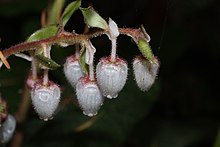| Gaultheria shallon | |
|---|---|
 |
|
| Scientific classification | |
| Kingdom: | Plantae |
| (unranked): | Angiosperms |
| (unranked): | Eudicots |
| (unranked): | Asterids |
| Order: | Ericales |
| Family: | Ericaceae |
| Genus: | Gaultheria |
| Species: | G. shallon |
Description
Gaultheria shallon is 0.2 to 5 m tall, sprawling to erect. Evergreen, its thick, tough, egg-shaped leaves are shiny and dark green on the upper surface, and rough and lighter green on the lower. Each finely and sharply serrate leaf is 5 to 10 cm long. The inflorescence consists of a bracteate raceme, one-sided, with 5 to 15 flowers at the ends of branches. Each flower is composed of a deeply five-parted glandular-haired calyx and an urn-shaped pink to white, glandular to hairy, five-lobed corolla, 7 to 10 mm long. The reddish to blue, rough-surfaced, hairy, nearly spherical fruit is 6 to 10 mm in diameter.[1]
Edibility
Its dark blue “berries” (actually swollen sepals[1]) and young leaves are both edible and are efficient appetite suppressants, both with a unique flavor. Gaultheria shallon berries were a significant food resource for native people, who both ate them fresh and dried them into cakes. They were also used as a sweetener, and the Haida used them to thicken salmon eggs. The leaves of the plant were also sometimes used to flavor fish soup.[1]
More recently, Gaultheria shallon berries are used locally in jams, preserves and pies.[1][3] They are often combined with Oregon-grape because the tartness of the latter is partially masked by the mild sweetness of Gaultheria shallon.
http://en.wikipedia.org/wiki/Salal





